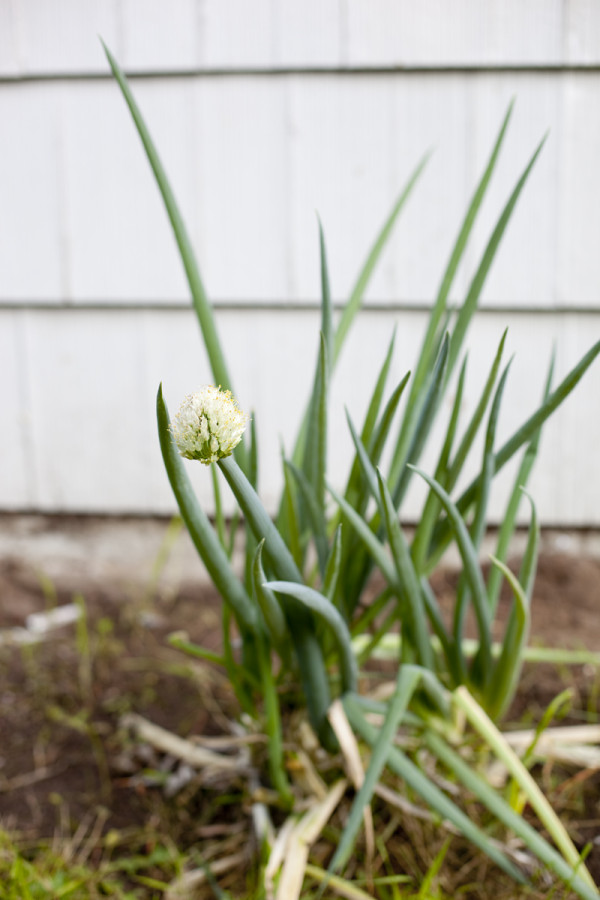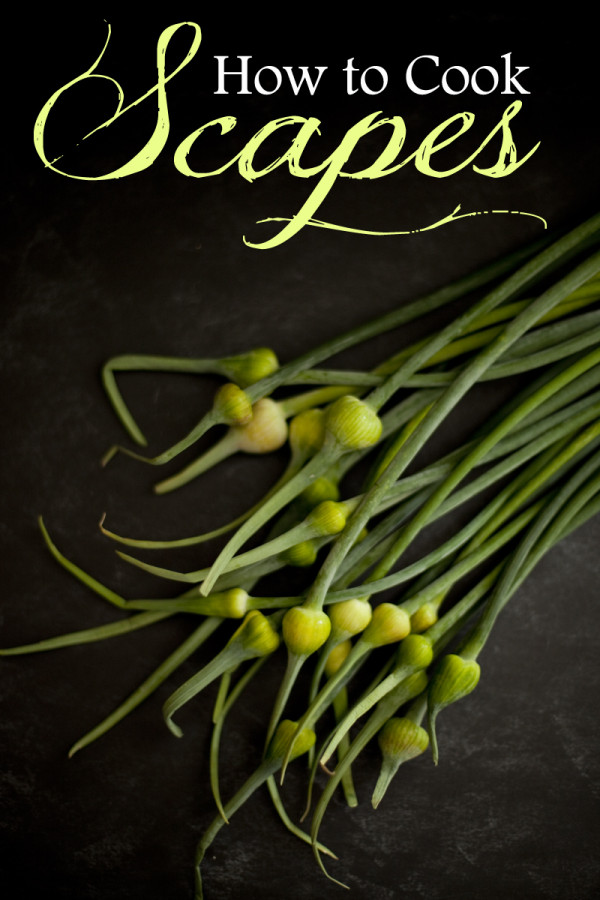“What the heck are these scape thingies?!!” There it is, one of those questions that so many people are afraid to ask because it just might show the world that they’re not a “real” foodie. Not to worry, I am one of those people who will happily reveal my ignorance for the benefit of the whole class.
Three years ago I was first asked about scapes by some cooking class participants who were doing a CSA for the first time, and I was equally oblivious. I had never heard of them and just thought they looked like little green onion domes perched on super skinny stalks. Turns out, they’re actually pretty special, and often found in gourmet or natural food stores. Which is funny, because they grow on some of the humblest plants in your veggie garden!
If you’ve ever planted garlic, leeks, or onions, or seen them growing somewhere in the spring, there’s a good chance you’ve seen scapes before. The scape is the flower stalk, and if left on the plant, will open up into a very pretty flower (like on my crazy overgrown green onions below). But it turns out that means the plant’s growing energy is going into the flower, and not the bulb that you are probably hoping to eat, so it’s better to follow the example of farmers much smarter and more experienced than me and try harvesting scapes before they blossom.
So yeah, they’re pretty cool looking, even before they flower, but I especially love them because I am such a fan of eating as many parts of a plant as possible. Exciting extras like pea shoots, kale flowers, or squash blossoms, make growing your own veggies even more special. And don’t even get me started on the money it can save you! No really, don’t, I could go on for pages.
This year, we are doing our CSA with Mosby Farms, and our very first box contained this large bunch of lovely spring green leek scapes. Now when I researched scapes a few years ago, I found a lot of recipes with garlic scapes, but it took me another year to realize that they also grow on leeks and onions. I have to admit (again, for the good of the class) that although I read a lot about them, this is my first year to actually try cooking with scapes.
In my hands on exploration this week, I’ve found that they’re delightfully mild versions of the plant they come from. So, if leeks taste like mild onions, I guess you could say that leek scapes taste like REALLY mild onions. I just say they’re delicious.
I found that cooking scapes is very similar to cooking onions, you can chop them up and use them in various recipes. But I also found them to be a lot like another favorite spring greenie, the oh so versatile asparagus. Though the flavor is quite different from asparagus, if you want to feature the scapes in a recipe or on their own, the cooking technique is pretty much the same.
Below are some quick tips for cooking with scapes, and a few links to some of my blogging buddies’ scape recipes that I’ll be trying this week. So get yourself to the nearest farmer’s market or fancy schmancy grocery store to find some scapes of your own. Or you could ask your clueless vegetable growing neighbor if they’d like you to cut off those pesky flowers before they blossom and steal all that growing energy. I won’t tell if you don’t!
How to Harvest Scapes:
Look for the spear or shoot with a small bulb coming out of the center of the plant. Depending on the plant (leek, onion, garlic) the bulb may be more elongated, and the shoot may have curled once or twice. Use sharp garden shears (or a pair of scissors if…ahem…you still don’t own garden shears) to cut the shoot off near the top set of leaves.
How to Cook Scapes:
Scapes chopped into small pieces are great substitutes for finely chopped onion. They can be a little tough, so if I’m using them in something like a quiche (oh yes, recipe is coming!), I give them a quick sauté first. You can chop scapes into larger pieces, about an inch, to use in stir fries, curries, pasta, and casseroles. If you’d like to really feature the scapes, try coating them in a little oil and roasting or grilling until tender, or cook and purée them into a scape pesto.
How to Preserve Scapes:
You can chop your scapes and freeze them in a plastic bag, then use them like any frozen vegetable, no need to thaw them first. I like saving frozen ones for using in soups in the winter when I’m desperate for spring. You can also pickle the scapes for a lovely snack or to add to an antipasto platter.
Scape Recipes:
Garlic Scape Carbonara – Sarah’s Cucina Bella
Garlic Scape Pesto – Dorie Greenspan
White Bean and Garlic Scape Dip – The Kitchn
Pickled Garlic Scapes – Not Without Salt
Garlic Scape Pizza – Herbivoraceous
Asian Pickled Leek Scapes – A Baking Life





Diana……I’m assuming that this does not include chives??? the stem that the flower grows on is a really different texture than the chive stems. What do you know about chives???
Great question! From what I’ve read and asking around, you can eat the chive scapes before they blossom, but it is more popular to let them blossom and then eat the flowers. They make very pretty garnishes and look great in salads.
My gardening friend gave me garlic scapes last year and they were the best! I coated them with olive oil and cooked them on the grill. I wish I would have planted garlic last fall just for the scapes.